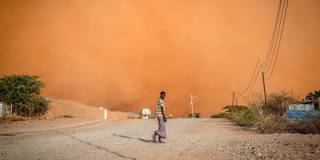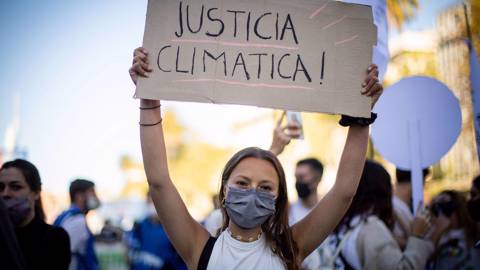Climate-driven humanitarian disasters are demonstrating why resilience and adaptation must become a high priority alongside climate-change mitigation. This reformulation of priorities will have far-reaching implications for the humanitarian sector.
NEW YORK – This year has been marked by horrendous humanitarian crises in eastern Africa and Afghanistan and terrifying climate-driven events around the world. But these issues are rarely discussed together because each is subject to different United Nations processes, different government departments, and different advocacy campaigns.
This must change. The fate of the climate and of the world’s poorest people are connected, and the movements dedicated to helping people who are most vulnerable and those called to protect the planet need to work better together – starting immediately.
The heatwaves, wildfires, and flash floods that swept across many Western countries this summer gave the world’s richest populations a taste of what it means to live at the mercy of nature. In the poorest countries, which have done the least to contribute to the climate crisis, that reality is already a part of daily life.
In eastern Africa, four consecutive seasons of failed rains – combined with the effects of regional conflicts, the COVID-19 pandemic, and the war in Ukraine – have caused extreme food insecurity for 20 million people. Although eastern Africa produces only 1.2% of global emissions and accounts for about 6% of the world’s population, it now includes 70% of all food-insecure people and 17% of global humanitarian need.
Recognizing that those least responsible for climate change are already paying the highest price for it, we at the International Rescue Committee (IRC) recently published the first-ever crisis supplement to our annual Emergency Watchlist to highlight the toll of suffering in East Africa. The original Watchlist for 2022 called out “system failure” and urged a system reboot; but our clients cannot wait for structural reform; they need immediate action. Moreover, we also see worsening humanitarian crises across the Middle East, Asia, and Latin America. Afghanistan, for example, has twice as many people at “level four” food insecurity (out of five levels in the International Phase Classification) as East Africa does.
Climate change threatens the poorest communities through chronic, dispersed risks such as insufficient water supply and sanitation, hunger, and the loss of natural ecosystems and livelihoods. These crises are not linear – they are slower moving cross-sectoral challenges that have serious and lasting implications.
These challenges are fundamental to the remit of the humanitarian enterprise. In rankings compiled by the Notre Dame Global Adaptation Initiative, six of the 11 countries least prepared for climate change – the Central African Republic, Somalia, the Democratic Republic of the Congo, Afghanistan, Sudan, and Niger – are also on the IRC’s Emergency Watchlist.
For these and many other countries, building climate resilience through adaptation must become a priority alongside climate-change mitigation. Here are three ways to start taking the climate emergency, and its impact on low-income and conflict-affected countries, seriously.
To start, donors must increase multiyear, flexible financing and ensure that a greater percentage of funding reaches frontline responders, who know their local environments and ecosystems best. Humanitarian programming should become more proactive, rather than reactive, when directing frontline responders to use these funds for staff, training, and equipment, thus building capacity to absorb, adapt, and respond to crises.
One dollar spent on early response and resilience saves three dollars in income and livestock losses. Learning what works – basing programs in evidence – helps to scale interventions in other humanitarian contexts. The best interventions for people caught up in crises are those that offer immediate assistance while also driving sustainable improvements. They not only keep people alive but also help them thrive.
The IRC has made it a priority to support research and innovation toward climate-resilient agricultural livelihoods in areas hardest hit by the magnifying effects of conflict and climate change. Farming will remain an economic mainstay in most low- and middle-income countries. Yet in the coming years, climate change will tax the capacity of food-production systems and the availability of natural resources, especially in places affected by soil degradation, lack of access to water, or desertification. With greater climate resilience in communities that are often left out of global negotiations, the people most vulnerable to climate change are empowered to determine their own needs and respond accordingly. This also has cascading positive effects on food security, migration, and conflict.
The IRC regards seed security, accessible and actionable information, and community-based disaster-risk reduction – such as early-warning systems – as focus areas where new and adapted approaches could make major advances in five years and deliver truly scalable solutions in ten years. In Niger, Pakistan, South Sudan, and Syria, we are building upon the foundations of our current work and exploring opportunities that leverage our expertise and existing tech know-how and production solutions to develop accessible, affordable, and innovative resilience-building strategies.
Moreover, there must be an increase in adaptation assistance for countries already dealing with incredibly difficult climatic conditions. We are still short of the $100 billion in annual climate financing that rich countries pledged in 2009. But beyond the drama of trying to reach that promised sum (which was set well before the current scientific analyses of vulnerability in climate-threatened areas), there is also the fundamental issue of how the money should be spent. Only 20% of public climate financing has gone to developing countries for adaptation projects, even though adaptation is critical to help people live with and minimize the destruction and suffering that comes from climate change.
A more appropriate target for adaptation funding would be 50% of climate financing, funded at the same level as mitigation, and delivered in the form of grants, not loans. These countries can ill-afford the interest-rate increases that are already feeding through from changes in macroeconomic policy in the richest parts of the world.
Finally, all public, private, and nonprofit actors must overcome bureaucratic barriers and start cooperating. Most humanitarian efforts today deal with economic, health, and conflict factors that exacerbate, and are exacerbated by, the effects of climate change, particularly in relatively inaccessible areas for on-the-ground climate work and research. That means there are valuable opportunities for cross-sectoral partnerships as well as crucial engagement with local communities, who know best their risks and how to solve them collectively.
For example, some of the IRC’s programs in Zimbabwe focus on the sustainable harvesting and trading of non-forest timber products. Public-private partnerships to consider the region’s climate change-related challenges, business models, and ecological considerations can provide a proactive framework to deal with uncertainty and assess interventions. Interventions are effective and sustainable only if they are suited to the local context, meet the perceived needs of the community, and are within its management capacity. This is an area where the climate and humanitarian movements can both do better.
The climate crisis represents a system failure of historic proportions. But there is system failure of a more specific kind in the world’s humanitarian hotspots, where one finds governments bombing their own citizens, impunity for war crimes, and diplomatic inertia. All suffer from the failure to prepare for climate risks, and this is what humanitarians and environmentalists need to work together to change.






NEW YORK – This year has been marked by horrendous humanitarian crises in eastern Africa and Afghanistan and terrifying climate-driven events around the world. But these issues are rarely discussed together because each is subject to different United Nations processes, different government departments, and different advocacy campaigns.
This must change. The fate of the climate and of the world’s poorest people are connected, and the movements dedicated to helping people who are most vulnerable and those called to protect the planet need to work better together – starting immediately.
The heatwaves, wildfires, and flash floods that swept across many Western countries this summer gave the world’s richest populations a taste of what it means to live at the mercy of nature. In the poorest countries, which have done the least to contribute to the climate crisis, that reality is already a part of daily life.
In eastern Africa, four consecutive seasons of failed rains – combined with the effects of regional conflicts, the COVID-19 pandemic, and the war in Ukraine – have caused extreme food insecurity for 20 million people. Although eastern Africa produces only 1.2% of global emissions and accounts for about 6% of the world’s population, it now includes 70% of all food-insecure people and 17% of global humanitarian need.
Recognizing that those least responsible for climate change are already paying the highest price for it, we at the International Rescue Committee (IRC) recently published the first-ever crisis supplement to our annual Emergency Watchlist to highlight the toll of suffering in East Africa. The original Watchlist for 2022 called out “system failure” and urged a system reboot; but our clients cannot wait for structural reform; they need immediate action. Moreover, we also see worsening humanitarian crises across the Middle East, Asia, and Latin America. Afghanistan, for example, has twice as many people at “level four” food insecurity (out of five levels in the International Phase Classification) as East Africa does.
Climate change threatens the poorest communities through chronic, dispersed risks such as insufficient water supply and sanitation, hunger, and the loss of natural ecosystems and livelihoods. These crises are not linear – they are slower moving cross-sectoral challenges that have serious and lasting implications.
SPRING SALE: Save 40% on all new Digital or Digital Plus subscriptions
Subscribe now to gain greater access to Project Syndicate – including every commentary and our entire On Point suite of subscriber-exclusive content – starting at just $49.99.
Subscribe Now
These challenges are fundamental to the remit of the humanitarian enterprise. In rankings compiled by the Notre Dame Global Adaptation Initiative, six of the 11 countries least prepared for climate change – the Central African Republic, Somalia, the Democratic Republic of the Congo, Afghanistan, Sudan, and Niger – are also on the IRC’s Emergency Watchlist.
For these and many other countries, building climate resilience through adaptation must become a priority alongside climate-change mitigation. Here are three ways to start taking the climate emergency, and its impact on low-income and conflict-affected countries, seriously.
To start, donors must increase multiyear, flexible financing and ensure that a greater percentage of funding reaches frontline responders, who know their local environments and ecosystems best. Humanitarian programming should become more proactive, rather than reactive, when directing frontline responders to use these funds for staff, training, and equipment, thus building capacity to absorb, adapt, and respond to crises.
One dollar spent on early response and resilience saves three dollars in income and livestock losses. Learning what works – basing programs in evidence – helps to scale interventions in other humanitarian contexts. The best interventions for people caught up in crises are those that offer immediate assistance while also driving sustainable improvements. They not only keep people alive but also help them thrive.
The IRC has made it a priority to support research and innovation toward climate-resilient agricultural livelihoods in areas hardest hit by the magnifying effects of conflict and climate change. Farming will remain an economic mainstay in most low- and middle-income countries. Yet in the coming years, climate change will tax the capacity of food-production systems and the availability of natural resources, especially in places affected by soil degradation, lack of access to water, or desertification. With greater climate resilience in communities that are often left out of global negotiations, the people most vulnerable to climate change are empowered to determine their own needs and respond accordingly. This also has cascading positive effects on food security, migration, and conflict.
The IRC regards seed security, accessible and actionable information, and community-based disaster-risk reduction – such as early-warning systems – as focus areas where new and adapted approaches could make major advances in five years and deliver truly scalable solutions in ten years. In Niger, Pakistan, South Sudan, and Syria, we are building upon the foundations of our current work and exploring opportunities that leverage our expertise and existing tech know-how and production solutions to develop accessible, affordable, and innovative resilience-building strategies.
Moreover, there must be an increase in adaptation assistance for countries already dealing with incredibly difficult climatic conditions. We are still short of the $100 billion in annual climate financing that rich countries pledged in 2009. But beyond the drama of trying to reach that promised sum (which was set well before the current scientific analyses of vulnerability in climate-threatened areas), there is also the fundamental issue of how the money should be spent. Only 20% of public climate financing has gone to developing countries for adaptation projects, even though adaptation is critical to help people live with and minimize the destruction and suffering that comes from climate change.
A more appropriate target for adaptation funding would be 50% of climate financing, funded at the same level as mitigation, and delivered in the form of grants, not loans. These countries can ill-afford the interest-rate increases that are already feeding through from changes in macroeconomic policy in the richest parts of the world.
Finally, all public, private, and nonprofit actors must overcome bureaucratic barriers and start cooperating. Most humanitarian efforts today deal with economic, health, and conflict factors that exacerbate, and are exacerbated by, the effects of climate change, particularly in relatively inaccessible areas for on-the-ground climate work and research. That means there are valuable opportunities for cross-sectoral partnerships as well as crucial engagement with local communities, who know best their risks and how to solve them collectively.
For example, some of the IRC’s programs in Zimbabwe focus on the sustainable harvesting and trading of non-forest timber products. Public-private partnerships to consider the region’s climate change-related challenges, business models, and ecological considerations can provide a proactive framework to deal with uncertainty and assess interventions. Interventions are effective and sustainable only if they are suited to the local context, meet the perceived needs of the community, and are within its management capacity. This is an area where the climate and humanitarian movements can both do better.
The climate crisis represents a system failure of historic proportions. But there is system failure of a more specific kind in the world’s humanitarian hotspots, where one finds governments bombing their own citizens, impunity for war crimes, and diplomatic inertia. All suffer from the failure to prepare for climate risks, and this is what humanitarians and environmentalists need to work together to change.